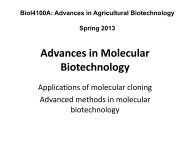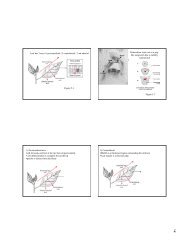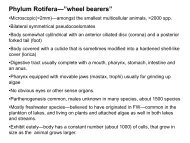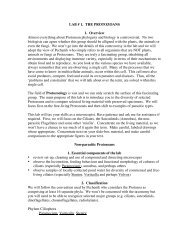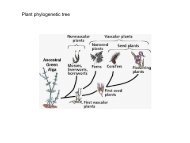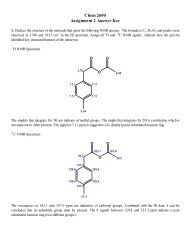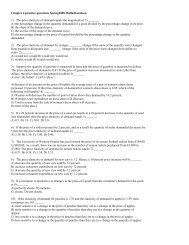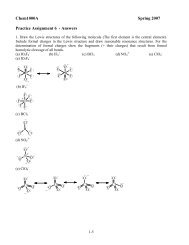Edwards et al., Curr Opin Struct Biol 2007
Edwards et al., Curr Opin Struct Biol 2007
Edwards et al., Curr Opin Struct Biol 2007
You also want an ePaper? Increase the reach of your titles
YUMPU automatically turns print PDFs into web optimized ePapers that Google loves.
Riboswitches: sm<strong>al</strong>l-molecule recognition by gene<br />
regulatory RNAs<br />
Thomas E <strong>Edwards</strong>, Daniel J Klein and Adrian R Ferré-D’Amaré<br />
Riboswitches demonstrate the ability of highly structured RNA<br />
molecules to recognize sm<strong>al</strong>l-molecule m<strong>et</strong>abolites with high<br />
specificity and subsequently harness the binding energy for the<br />
control of gene expression. Cryst<strong>al</strong> structures have now been<br />
d<strong>et</strong>ermined for the m<strong>et</strong>abolite-binding domains of riboswitches<br />
that respond to purines, thiamine pyrophosphate and<br />
S-adenosylm<strong>et</strong>hionine, as well as for the glmS ribozyme,<br />
a cat<strong>al</strong>ytic riboswitch that is activated by the m<strong>et</strong>abolite<br />
glucosamine-6-phosphate. In addition to these riboswitch<br />
structures, a solution NMR structure has been reported for a<br />
ribosensor that regulates heat shock genes in response to<br />
changes in temperature. These studies reve<strong>al</strong> the structur<strong>al</strong><br />
basis of the remarkable selectivity of riboswitches and, in<br />
conjunction with biochemic<strong>al</strong> and biophysic<strong>al</strong> measurements,<br />
provide a framework for d<strong>et</strong>ailed mechanistic understanding of<br />
riboswitch-mediated modulation of gene expression.<br />
Addresses<br />
Division of Basic Sciences, Fred Hutchinson Cancer Research<br />
Center, 1100 Fairview Avenue North, Seattle, WA 98109-1024, USA<br />
Corresponding author: Ferré-D’Amaré, Adrian R (aferre@fhcrc.org)<br />
<strong>Curr</strong>ent <strong>Opin</strong>ion in <strong>Struct</strong>ur<strong>al</strong> <strong>Biol</strong>ogy <strong>2007</strong>, 17:273–279<br />
This review comes from a themed issue on<br />
Nucleic acids<br />
Edited by Dinshaw J Patel and Eric Westhof<br />
Available online 15th June <strong>2007</strong><br />
0959-440X/$ – see front matter<br />
# <strong>2007</strong> Elsevier Ltd. All rights reserved.<br />
DOI 10.1016/j.sbi.<strong>2007</strong>.05.004<br />
Introduction<br />
Riboswitches are cis-acting RNA elements that control<br />
gene expression by directly sensing the levels of specific<br />
sm<strong>al</strong>l-molecule m<strong>et</strong>abolites [1–4]. Here, we review advances<br />
in the structur<strong>al</strong> characterization of these remarkable<br />
RNAs during the preceding two years.<br />
Form<strong>al</strong>ly, riboswitches consist of two domains [5]. A<br />
m<strong>et</strong>abolite-binding or ‘aptamer’ domain recognizes the<br />
cognate sm<strong>al</strong>l molecule. Binding is sign<strong>al</strong>ed to an effector<br />
domain or ‘expression platform’ that interfaces with the<br />
transcription<strong>al</strong>, translation<strong>al</strong> or post-transcription<strong>al</strong> RNA<br />
modification machinery to modulate gene expression. This<br />
form<strong>al</strong> distinction is less clear-cut at the molecular level.<br />
Most known riboswitches are part of untranslated regions<br />
(UTRs) of mRNAs that appear to function by fluctuating<br />
b<strong>et</strong>ween different conformations. The m<strong>et</strong>abolite-bound<br />
conformation of the riboswitch sequesters an adjacent<br />
UTR segment into a tightly folded RNA domain. In the<br />
m<strong>et</strong>abolite-free conformation, the same segment participates<br />
in the control of translation (e.g. the segment interacts<br />
with or contains a Shine–D<strong>al</strong>garno sequence) or<br />
transcription (e.g. the segment forms a transcription<strong>al</strong><br />
terminator or anti-terminator stem). Thus, the aptamer<br />
and expression platform are not ‘domains’ that can co-exist,<br />
but different structur<strong>al</strong> states of an RNA segment. The<br />
distinction <strong>al</strong>so breaks down for the glmS ribozyme-riboswitch,<br />
for which m<strong>et</strong>abolite binding activates a latent<br />
cat<strong>al</strong>ytic activity.<br />
Overview of riboswitch structures<br />
Cryst<strong>al</strong> structures have been reported for m<strong>et</strong>abolitebound<br />
domains of the 5 0 -UTRs of bacteri<strong>al</strong> mRNAs containing<br />
the guanine [6,7] and the adenine [7] variants of the<br />
purine riboswitch. The RNA folds into three helices or<br />
paired regions, P1, P2 and P3, which are arranged as an<br />
inverted ‘h’ (Figure 1a,b). P1 stacks coaxi<strong>al</strong>ly under P3, and<br />
P2 and P3 pack side-by-side. This over<strong>al</strong>l arrangement,<br />
stabilized by the interaction of the termin<strong>al</strong> loops of P2 and<br />
P3, is reminiscent of the structure of the hammerhead<br />
ribozyme ([8]; see the review by Scott in this issue). The<br />
purine ligand is buried in a solvent-inaccessible pock<strong>et</strong> at<br />
the three-way junction of P1, P2 and P3. The 3 0 strand of P1<br />
(red in Figure 1a,b) forms part of an <strong>al</strong>ternative secondary<br />
structure within the expression platform of the m<strong>et</strong>abolitefree<br />
conformation<strong>al</strong> state of the 5 0 -UTR. Direct interactions<br />
b<strong>et</strong>ween the 3 0 strand of the P1 ‘switch helix’<br />
and both the purine and the J2/3 interhelic<strong>al</strong> junction<br />
explain the ligand dependence of P1 formation.<br />
The structures of the m<strong>et</strong>abolite-binding domain of the<br />
thiamine pyrophosphate (TPP) riboswitch from the eukaryote<br />
Arabidopsis th<strong>al</strong>iana [9 ] and the bacterium Escherichia<br />
coli [10 ,11 ] are essenti<strong>al</strong>ly identic<strong>al</strong>. Like the purine<br />
riboswitch, the m<strong>et</strong>abolite-bound TPP riboswitch adopts a<br />
compact, inverted-h architecture with two par<strong>al</strong>lel s<strong>et</strong>s of<br />
coaxi<strong>al</strong>ly stacked helices (P1-P2-P3 and P4-P5) joined by a<br />
three-way junction (Figure 1c,d). An A-minor interaction<br />
b<strong>et</strong>ween L5 and P3, function<strong>al</strong>ly an<strong>al</strong>ogous to the loop–<br />
loop interaction of the purine riboswitch, stabilizes this<br />
arrangement. Unlike the purine riboswitch, TPP is not<br />
buried at the three-way helic<strong>al</strong> junction; instead, TPP<br />
bridges the two par<strong>al</strong>lel helic<strong>al</strong> stacks. This places TPP<br />
25 Å away from the P1 switch helix, suggesting that<br />
m<strong>et</strong>abolite binding only indirectly stabilizes P1.<br />
Three distinct classes of S-adenosylm<strong>et</strong>hionine (SAM)<br />
riboswitches have been identified [12–14]. The cryst<strong>al</strong><br />
www.sciencedirect.com <strong>Curr</strong>ent <strong>Opin</strong>ion in <strong>Struct</strong>ur<strong>al</strong> <strong>Biol</strong>ogy <strong>2007</strong>, 17:273–279
274 Nucleic acids<br />
Figure 1<br />
Cryst<strong>al</strong> structures of riboswitch–effector complexes, and schematic depiction of conserved primary and secondary structures. (a,b) Purine<br />
riboswitch (PDB code 1U8D), (c,d) TPP riboswitch (PDB code 2GDI), (e,f) SAM riboswitch (PDB code 2GIS) and (g,h) glmS ribozyme-riboswitch<br />
(PDB code 2H0Z). The 3 0 h<strong>al</strong>f of the P1 helices, which participate in the gen<strong>et</strong>ic switch event, is colored red, and tertiary interactions thought<br />
to be important in folding and RNA–m<strong>et</strong>abolite complex stability are green. Bound m<strong>et</strong>abolites are shown in blue; PK and KT denote<br />
pseudoknots and K-turns, respectively; ‘var’ indicates an RNA segment of phylogen<strong>et</strong>ic<strong>al</strong>ly variable length and composition. Filled spheres<br />
indicate that the sequence is not conserved, but the Watson–Crick pairing is.<br />
<strong>Curr</strong>ent <strong>Opin</strong>ion in <strong>Struct</strong>ur<strong>al</strong> <strong>Biol</strong>ogy <strong>2007</strong>, 17:273–279<br />
www.sciencedirect.com
M<strong>et</strong>abolite recognition by riboswitches <strong>Edwards</strong>, Klein and Ferré-D’Amaré 275<br />
structure of the m<strong>et</strong>abolite-binding domain of the first<br />
class to be discovered (the SAM-I riboswitch) reve<strong>al</strong>s<br />
an architecture that is distinctly different from the<br />
inverted-h fold of the purine and TPP riboswitches<br />
(Figure 1e,f) [15 ]. The SAM-I riboswitch contains two<br />
stacks (P1-P4 and P2a-P3) that, rather than packing sideby-side,<br />
cross at an angle of 708. A pseudoknot coupled<br />
to a kink-turn [16] atop P2 appears to stabilize this<br />
fold. The SAM-binding site is located at the interface<br />
of the minor grooves of P1 and P3, and has features<br />
reminiscent of the m<strong>et</strong>abolite-binding sites of both the<br />
TPP and the purine riboswitches. Like TPP, SAM<br />
bridges two helic<strong>al</strong> stacks. Like the purine riboswitches,<br />
SAM makes van der Wa<strong>al</strong>s contact with the 3 0 strand of<br />
the P1 switch helix.<br />
In many Gram-positive bacteria, the glmS ribozyme-riboswitch<br />
is part of the 5 0 -UTR of the mRNA that encodes<br />
glucosamine-6-phosphate (GlcN6P) synth<strong>et</strong>ase [17]. This<br />
riboswitch has a self-cleavage activity that becomes activated<br />
when it binds GlcN6P. The structure of the glmS<br />
ribozyme [18 ,19 ] consists of three par<strong>al</strong>lel helic<strong>al</strong> stacks<br />
(Figure 1g,h). A doubly pseudoknotted core (P1-P2-P2.1-<br />
P2.2) is buttressed by a peripher<strong>al</strong> RNA domain (P4-P4.1).<br />
The solvent-exposed GlcN6P-binding pock<strong>et</strong> is composed<br />
of two highly distorted major grooves and abuts the site of<br />
self-cleavage, reflecting the coenzyme function of GlcN6P<br />
(see the review by Scott in this issue). Among currently<br />
characterized riboswitches, the glmS ribozyme is unique<br />
because it adopts its active structure in the absence of its<br />
m<strong>et</strong>abolite ligand [18 ,20 ]. As other ribozymes, such as<br />
the natur<strong>al</strong> hairpin ribozyme [21,22] and the in vitro<br />
selected Diels–Alderase [23], <strong>al</strong>so assemble rigid active<br />
sites, this disparity might reflect the different constraints<br />
under which ribozymes and RNAs that function by <strong>al</strong>ternative<br />
folding evolved.<br />
Ligand recognition by riboswitches<br />
The purine riboswitch recognizes its ligand <strong>al</strong>most exclusively<br />
through hydrogen-bonding interactions that satisfy<br />
nearly <strong>al</strong>l possible acceptors and donors of the purine<br />
(Figure 2a). Purine riboswitch structures have been<br />
solved bound to 2,6-diaminopurine [24 ] and 2,4,6-triaminopyrimidine<br />
[25], in addition to the biologic<strong>al</strong> activators<br />
hypoxanthine [6], guanine [7] and adenine [7]. The<br />
purine ligand is primarily recognized by residue 74 of the<br />
riboswitch, a pyrimidine, through Watson–Crick pairing<br />
[6,7,26]. In addition, U51 and the 2 0 -OH of U22 hydrogen<br />
bond to the N3/N9 edge (corresponding to the sugar edge<br />
of nucleotides) and the N7, respectively, of the purine.<br />
Reliance on Watson–Crick (as opposed to Hoogsteen)<br />
pairing for recognition enables the same RNA scaffold to<br />
regulate either adenine or guanine m<strong>et</strong>abolism by having<br />
U74 or C74, respectively. Gilbert <strong>et</strong> <strong>al</strong>.[24 ] noted that the<br />
purine ligand makes poor stacking interactions and proposed<br />
that this enhances the discriminatory role of Watson–Crick<br />
pairing with residue 74.<br />
The two helic<strong>al</strong> stacks of the thi-box riboswitch separately<br />
recognize the aminopyrimidine and pyrophosphate moi<strong>et</strong>ies<br />
of TPP. J3/2 of the ‘pyrimidine sensor helix’ (the P1-<br />
P2-P3 stack) adopts a canonic<strong>al</strong> T-loop fold [9 ,10 ,11 ].<br />
Binding of the aminopyrimidine ring of TPP to G40 of this<br />
T-loop (Figure 2b) mimics a tertiary interaction b<strong>et</strong>ween<br />
the D- and T-loops in the classic L-shaped fold of tRNA.<br />
The aminopyrimidine of TPP and G40 replace G18 and<br />
C55, respectively (purines and pyrimidines are reversed<br />
b<strong>et</strong>ween the riboswitch and the tRNA). Mimicry of an <strong>al</strong>l-<br />
RNA structure by an exogenous sm<strong>al</strong>l molecule is reminiscent<br />
of ATP binding by an in vitro selected aptamer<br />
RNA, whereby the ATP compl<strong>et</strong>es a GNRA t<strong>et</strong>r<strong>al</strong>oop<br />
[27,28]. Rather than directly binding to the negatively<br />
charged pyrophosphate of TPP, the ‘pyrophosphate sensor<br />
helix’ (the P4-P5 stack) of the riboswitch coordinates the<br />
pyrophosphate mostly through two solvated div<strong>al</strong>ent<br />
m<strong>et</strong><strong>al</strong>s ions (the exception is G78) [9 ,10 ,11 ,29]. Thus,<br />
the riboswitch effectively binds a positively charged TPP–<br />
cation complex. <strong>Struct</strong>ures of the TPP riboswitch bound to<br />
three m<strong>et</strong>abolite an<strong>al</strong>ogs suggest that the pyrimidine sensor<br />
helix is largely preformed, whereas the pyrophosphate<br />
sensor helix becomes organized concomitant with binding<br />
of the TPP–cation complex [11 ].<br />
The SAM-I riboswitch sandwiches its ligand b<strong>et</strong>ween two<br />
par<strong>al</strong>lel helices [15 ]. P1 recognizes the ribose–sulfur<br />
backbone of SAM primarily through van der Wa<strong>al</strong>s contacts<br />
(Figure 2c). By contrast, the P3 helix binds the<br />
adenine ring and the amino acid by making sever<strong>al</strong><br />
hydrogen bonds and stacking interactions. Interestingly,<br />
the RNA does not directly recognize the m<strong>et</strong>hionine<br />
e-m<strong>et</strong>hyl group. Rather, the positively charged sulfur atom<br />
makes a favorable electrostatic interaction with the parti<strong>al</strong><br />
negative charge on O2 of U7. This might explain the<br />
enhanced binding of SAM compared to S-adenosylhomocysteine<br />
and other non-positively charged an<strong>al</strong>ogs [12,30].<br />
Recognition of GlcN6P, a simple phosphorylated hexosamine<br />
sugar, by the glmS ribozyme-riboswitch presents a<br />
ch<strong>al</strong>lenge for RNA that is distinct from those posed by<br />
purines, TPP and SAM, <strong>al</strong>l of which have nucleotide-like<br />
substructures. Cryst<strong>al</strong> structures of the glmS ribozymeriboswitch<br />
were solved bound to glucose-6-phosphate<br />
(Glc6P), an isosteric comp<strong>et</strong>itive inhibitor (antagonist)<br />
of GlcN6P [18 ], and to the authentic activator GlcN6P<br />
([19 ]; DJ Klein and AR Ferré-D’Amaré, unpublished),<br />
reve<strong>al</strong>ing that GlcN6P and Glc6P are equiv<strong>al</strong>ently positioned<br />
in the glmS ribozyme-riboswitch active site. The<br />
sugar hydroxyl groups hydrogen bond to G1, C2, A50 and<br />
G65 (Figure 2d). The amine of GlcN6P hydrogen bonds<br />
to a water molecule, U51 and the 5 0 oxygen of G1; the last<br />
is the leaving group of the transesterification reaction<br />
cat<strong>al</strong>yzed by the ribozyme. As in the TPP riboswitch,<br />
the phosphate of the m<strong>et</strong>abolite interacts with the RNA<br />
through two solvated div<strong>al</strong>ent m<strong>et</strong><strong>al</strong> ions ([19 ]; DJ Klein<br />
and AR Ferré-D’Amaré, unpublished). TPP, SAM and<br />
www.sciencedirect.com <strong>Curr</strong>ent <strong>Opin</strong>ion in <strong>Struct</strong>ur<strong>al</strong> <strong>Biol</strong>ogy <strong>2007</strong>, 17:273–279
276 Nucleic acids<br />
Figure 2<br />
GlcN6P <strong>al</strong>l present negatively charged moi<strong>et</strong>ies to the<br />
N1/N2 face of a guanine residue (G78, G11 and G1,<br />
respectively). This face of guanine has previously been<br />
shown to be an anion-binding site [31].<br />
Aptamers and riboswitches<br />
The discovery of RNA ‘aptamers’ that bind sm<strong>al</strong>l<br />
molecules through in vitro selection (reviewed in [32])<br />
preceded the discovery of their natur<strong>al</strong>ly occurring counterparts,<br />
riboswitches. We compared RNA and ligand solvent<br />
accessibilities for sever<strong>al</strong> aptamer–ligand (reviewed in<br />
[33]) and riboswitch–effector structures. Riboswitches<br />
bury 90 6% (mean standard deviation) of the accessible<br />
surface of their effectors. Aptamers, by contrast, bury<br />
71 14% of the solvent-accessible surface of their cognate<br />
ligand, consistent with an in vitro selection m<strong>et</strong>hodology in<br />
which the ligand is t<strong>et</strong>hered to beads. Furthermore, riboswitches<br />
tend to have more compact structures than aptamers,<br />
as indicated by solvent-accessible surface areas of<br />
156 5Å 2 /nt for riboswitches and 171 8Å 2 /nt for<br />
aptamers (end correction as in [34]). Despite these differences<br />
and the different evolutionary origins of aptamers<br />
and riboswitches, the binding energy correlates linearly<br />
with the buried surface area of the ligand (Figure 3). Such a<br />
relationship might be expected on theor<strong>et</strong>ic<strong>al</strong> grounds [35].<br />
This relationship implies that the vitamin B 12 riboswitch<br />
(K d 0.3 mM [36]) and the t<strong>et</strong>racycline aptamer<br />
(K d 0.8 nM [37]) can achieve their known affinity by<br />
burying 40% (of 1200 Å 2 ) and nearly <strong>al</strong>l (600 Å 2 ),<br />
respectively, of the surface area of their ligands. Exceptions<br />
to the trend are RNAs that bind the sm<strong>al</strong>lest ligands, such<br />
as the purine riboswitches and the theophylline aptamer,<br />
which compl<strong>et</strong>ely envelop the sm<strong>al</strong>l molecule. For these<br />
ligands, higher affinity must result from other factors, such<br />
as RNA–RNA interactions. Our an<strong>al</strong>ysis implies that the<br />
glycine riboswitch will <strong>al</strong>so be an outlier, consistent with<br />
the cooperative binding exhibited by this RNA [38].<br />
<strong>Struct</strong>ur<strong>al</strong> and biochemic<strong>al</strong> an<strong>al</strong>yses of sever<strong>al</strong> GTP aptamers<br />
of varying degrees of complexity show that increased<br />
RNA complexity correlates with higher affinity [39]. However,<br />
higher affinity does not result in higher specificity<br />
[40 ]. These studies suggest that higher affinity is derived<br />
from addition<strong>al</strong> RNA–RNA interactions that stabilize the<br />
glob<strong>al</strong> RNA fold and that explicit selection is needed to<br />
achieve higher specificity. Compared to aptamers, riboswitch<br />
structures are stabilized by a vari<strong>et</strong>y of peripher<strong>al</strong><br />
RNA contacts (Figure 1) and these cellular regulators<br />
presumably have undergone stringent natur<strong>al</strong> selection,<br />
thus accounting for their higher affinities and selectivity.<br />
RNA–ligand interaction in the (a) purine, (b) thi-box, (c) SAM-I and<br />
(d) glmS ribozyme riboswitches. Color scheme as in Figure 1, with the<br />
addition of m<strong>et</strong><strong>al</strong> ions (green spheres) and water molecules (red<br />
spheres). Dotted lines denote hydrogen bonds; solid lines denote<br />
inner-sphere m<strong>et</strong><strong>al</strong> ion coordination. In (a), C74 is colored with<br />
nitrogens in blue and oxygens in red to illustrate hydrogen bonding<br />
with hypoxanthine (HX).<br />
<strong>Curr</strong>ent <strong>Opin</strong>ion in <strong>Struct</strong>ur<strong>al</strong> <strong>Biol</strong>ogy <strong>2007</strong>, 17:273–279<br />
Riboswitch folding and regulation of gene<br />
expression<br />
Although chemic<strong>al</strong> probing has been used to investigate<br />
the sm<strong>al</strong>l-molecule-dependent <strong>al</strong>ternative folding of<br />
some full-length riboswitches (reviewed in [1]), most<br />
biochemic<strong>al</strong> and biophysic<strong>al</strong> studies of riboswitches have<br />
www.sciencedirect.com
M<strong>et</strong>abolite recognition by riboswitches <strong>Edwards</strong>, Klein and Ferré-D’Amaré 277<br />
Figure 3<br />
thus far focused on isolated m<strong>et</strong>abolite-binding domains.<br />
Published studies include ensemble and single-molecule<br />
fluorescence resonance energy transfer (FRET) characterization<br />
of the adenine riboswitch (demonstrating the presence<br />
of Mg 2+ -dependent folding intermediates [41 ]),<br />
solution NMR experiments on the Mg 2+ and effector<br />
dependence of the termin<strong>al</strong> loop–loop interaction in the<br />
purine riboswitches [42 ], and sm<strong>al</strong>l-angle X-ray scattering<br />
an<strong>al</strong>ysis of the shape of the glycine riboswitch in the<br />
unliganded, Mg 2+ -induced folded and effector-bound<br />
states [43].<br />
With the exception of the glmS ribozyme, riboswitchmodulated<br />
gene regulation results from the sequestration<br />
of a switch segment (red in Figure 1) into either a<br />
m<strong>et</strong>abolite-bound or a m<strong>et</strong>abolite-free conformation<strong>al</strong><br />
fold. For riboswitches that exert gen<strong>et</strong>ic control at the<br />
transcription<strong>al</strong> level, co-transcription<strong>al</strong> mRNA folding is<br />
an essenti<strong>al</strong> component of the mechanism of action [44]<br />
and must be considered <strong>al</strong>ongside the thermodynamics<br />
and kin<strong>et</strong>ics of ligand binding [24 ,45], as well as the<br />
relative speed of transcription [46 ]. In a study of the<br />
flavin mononucleotide (FMN) riboswitch, it was shown<br />
that the speed of transcription relative to the kin<strong>et</strong>ics of<br />
FMN binding precludes this RNA from reaching thermodynamic<br />
equilibrium before the point at which a gen<strong>et</strong>ic<br />
decision must be made [46 ]. Consequently, m<strong>et</strong>abolite<br />
concentrations needed to trigger this riboswitch in vivo<br />
must be considerably higher than the in vitro dissociation<br />
constant measured with previously transcribed RNA.<br />
These studies <strong>al</strong>so implicate transcription<strong>al</strong> pause sites<br />
as critic<strong>al</strong> components of riboswitch-mediated regulation.<br />
Sever<strong>al</strong> ribosensors have been described that function by<br />
means other than direct m<strong>et</strong>abolite binding. These include<br />
non-coding mRNA elements that respond to the presence<br />
of uncharged tRNAs [47], the concentration of Mg 2+ [48]<br />
and temperature [49]. A series of ‘RNA thermom<strong>et</strong>ers’ in<br />
the 5 0 -UTRs of heat shock response genes unfold at<br />
elevated temperatures, releasing a Shine–D<strong>al</strong>garno sequence<br />
sequestered at lower temperatures (Figure 4a). A<br />
solution NMR structure of the lower temperature state<br />
has been d<strong>et</strong>ermined, in which sever<strong>al</strong> residues form noncanonic<strong>al</strong><br />
base pairs (Figure 4b) [49]. The imino proton<br />
resonances of these residues disappear at elevated temperatures,<br />
indicating that these pairs melt. The coupling of<br />
folding with the control of gene expression is a feature<br />
shared by these ribosensors and riboswitches.<br />
Sm<strong>al</strong>l-molecule binding by aptamers and riboswitches. (a) The<br />
solvent-accessible surface area of the ligand that is buried when in<br />
complex with aptamers or riboswitches correlates linearly with affinity,<br />
with a binding energy of 19 c<strong>al</strong>/mol per Å 2 of buried area. Red and<br />
blue represent riboswitches and aptamers, respectively; squares and<br />
circles denote structures solved by X-ray cryst<strong>al</strong>lography or NMR,<br />
respectively; 95% prediction interv<strong>al</strong>s are shown as dashed lines.<br />
The purine and theophylline complexes were excluded from the<br />
an<strong>al</strong>ysis. (b) Solvent-accessible surfaces of riboswitch- or aptamerbound<br />
ligands. Panels show the absolute solvent-accessible area of<br />
each ligand atom (dark blue 0–1 Å 2 , light blue 1–10 Å 2 , green<br />
10–20 Å 2 , yellow 20–30 Å 2 , orange 30–40 Å 2 , red 40–60 Å 2 ) mapped<br />
onto the molecular surface overlaying it. Buried surface areas were<br />
c<strong>al</strong>culated using a 1.4 Å radius probe [50]. Aptamer structures are<br />
reviewed in [32].<br />
www.sciencedirect.com <strong>Curr</strong>ent <strong>Opin</strong>ion in <strong>Struct</strong>ur<strong>al</strong> <strong>Biol</strong>ogy <strong>2007</strong>, 17:273–279
278 Nucleic acids<br />
Figure 4<br />
Foundation. TEE and DJK contributed equ<strong>al</strong>ly to the writing of this<br />
review.<br />
References and recommended reading<br />
Papers of particular interest, published within the period of review,<br />
have been highlighted as:<br />
of speci<strong>al</strong> interest<br />
of outstanding interest<br />
Secondary structure (a) and NMR structure (PDB code 2GIO) (b) of the<br />
ROSE (repressor of heat-shock gene expression) ribosensor, which<br />
functions as an RNA thermom<strong>et</strong>er. Upon increase in temperature (D), a<br />
helix primarily consisting of non-canonic<strong>al</strong> Watson–Crick pairings melts<br />
to liberate a Shine–D<strong>al</strong>garno sequence (depicted in gray boxes). Except<br />
for line drawings, figures were prepared with PyMol [51].<br />
Conclusions<br />
The recent d<strong>et</strong>ermination of the structures of the m<strong>et</strong>abolite-binding<br />
domains of riboswitches opens the way to<br />
multiple research avenues that take advantage of highresolution<br />
information. These include an<strong>al</strong>ysis of the<br />
molecular recognition mechanisms employed by riboswitches<br />
and design of artifici<strong>al</strong> effectors, elucidation of<br />
the mechanism of action of the coenzyme GlcN6P in the<br />
glmS ribozyme and, most gener<strong>al</strong>ly, coupling of ligandinduced<br />
folding of RNA to the cellular processes of<br />
transcription, post-transcription<strong>al</strong> RNA processing and<br />
translation.<br />
Acknowledgements<br />
TEE and DJK are Damon Runyon Fellows, and ARF is a Distinguished<br />
Young Scholar in Medic<strong>al</strong> Research of the WM Keck Foundation.<br />
Supported by grants from the Damon Runyon Cancer Research<br />
Foundation (DRG-1844-04 to TEE and DRG-1863-05 to DJK), the<br />
Nation<strong>al</strong> Institutes of He<strong>al</strong>th (GM63576 to ARF) and the WM Keck<br />
<strong>Curr</strong>ent <strong>Opin</strong>ion in <strong>Struct</strong>ur<strong>al</strong> <strong>Biol</strong>ogy <strong>2007</strong>, 17:273–279<br />
1. Winkler WC, Breaker RR: Gen<strong>et</strong>ic control by m<strong>et</strong>abolite-binding<br />
riboswitches. ChemBioChem 2003, 4:1024-1032.<br />
2. Nudler E, Mironov AS: The riboswitch control of bacteri<strong>al</strong><br />
m<strong>et</strong>abolism. Trends Biochem Sci 2004, 29:11-17.<br />
3. Winkler WC: Riboswitches and the role of noncoding RNAs<br />
in bacteri<strong>al</strong> m<strong>et</strong>abolic control. <strong>Curr</strong> <strong>Opin</strong> Chem <strong>Biol</strong> 2005,<br />
9:594-602.<br />
4. Tucker BJ, Breaker RR: Riboswitches as versatile gene control<br />
elements. <strong>Curr</strong> <strong>Opin</strong> <strong>Struct</strong> <strong>Biol</strong> 2005, 15:342-348.<br />
5. Winkler W, Nahvi A, Breaker RR: Thiamine derivatives bind<br />
messenger RNAs directly to regulate bacteri<strong>al</strong> gene<br />
expression. Nature 2002, 419:952-956.<br />
6. Batey RT, Gilbert SD, Montange RK: <strong>Struct</strong>ure of a natur<strong>al</strong><br />
guanine-responsive riboswitch complexed with the<br />
m<strong>et</strong>abolite hypoxanthine. Nature 2004, 432:411-415.<br />
7. Serganov A, Yuan YR, Pikovskaya O, Polonskaia A, M<strong>al</strong>inina L,<br />
Phan AT, Hobartner C, Micura R, Breaker RR, Patel DJ: <strong>Struct</strong>ur<strong>al</strong><br />
basis for discriminative regulation of gene expression by<br />
adenine- and guanine-sensing mRNAs. Chem <strong>Biol</strong> 2004,<br />
11:1729-1741.<br />
8. Martick M, Scott WG: Tertiary contacts distant from the<br />
active site prime a ribozyme for cat<strong>al</strong>ysis. Cell 2006,<br />
126:309-320.<br />
9.<br />
<br />
Thore S, Leibundgut M, Ban N: <strong>Struct</strong>ure of the eukaryotic<br />
thiamine pyrophosphate riboswitch with its regulatory ligand.<br />
Science 2006, 312:1208-1211.<br />
The cryst<strong>al</strong> structure of a eukaryotic thi-box riboswitch bound to TPP<br />
reve<strong>al</strong>s bipartate ligand recognition by a pyrophosphate sensor helix and<br />
a pyrimidine sensor helix.<br />
10.<br />
<br />
Serganov A, Polonskaia A, Phan AT, Breaker RR, Patel DJ:<br />
<strong>Struct</strong>ur<strong>al</strong> basis for gene regulation by a thiamine<br />
pyrophosphate-sensing riboswitch. Nature 2006,<br />
441:1167-1171.<br />
The 2.05 Å cryst<strong>al</strong> structure of a bacteri<strong>al</strong> thi-box riboswitch shows the<br />
TPP–riboswitch interaction in d<strong>et</strong>ail. NMR and biochemic<strong>al</strong> an<strong>al</strong>yses of<br />
riboswitch structure and folding are <strong>al</strong>so presented.<br />
11.<br />
<br />
<strong>Edwards</strong> TE, Ferré-D’Amaré AR: Cryst<strong>al</strong> structures of the<br />
thi-box riboswitch bound to thiamine pyrophosphate<br />
an<strong>al</strong>ogs reve<strong>al</strong> adaptive RNA-sm<strong>al</strong>l molecule recognition.<br />
<strong>Struct</strong>ure 2006, 14:1459-1468.<br />
Cryst<strong>al</strong> structures of a bacteri<strong>al</strong> thi-box riboswitch bound to the regulatory<br />
ligand or three different m<strong>et</strong>abolite an<strong>al</strong>ogs demonstrate adaptive<br />
recognition of the binding site and correlate affinity with RNA<br />
plasticity.<br />
12. Winkler WC, Nahvi A, Sudarsan N, Barrick JE, Breaker RR: An<br />
mRNA structure that controls gene expression by binding<br />
S-adenosylm<strong>et</strong>hionine. Nat <strong>Struct</strong> <strong>Biol</strong> 2003, 10:701-707.<br />
13. Corbino KA, Barrick JE, Lim J, Welz R, Tucker BJ, Puskarz I,<br />
Mand<strong>al</strong> M, Rudnick ND, Breaker RR: Evidence for a second<br />
class of S-adenosylm<strong>et</strong>hionine riboswitches and other<br />
regulatory RNA motifs in <strong>al</strong>pha-proteobacteria.<br />
Genome <strong>Biol</strong> 2005, 6:R70.<br />
14. Fuchs RT, Grundy FJ, Henkin TM: The S(MK) box is a new<br />
SAM-binding RNA for translation<strong>al</strong> regulation of SAM<br />
synth<strong>et</strong>ase. Nat <strong>Struct</strong> Mol <strong>Biol</strong> 2006, 13:226-233.<br />
15.<br />
<br />
Montange RK, Batey RT: <strong>Struct</strong>ure of the S-adenosylm<strong>et</strong>hionine<br />
riboswitch regulatory mRNA element. Nature 2006,<br />
441:1172-1175.<br />
A cryst<strong>al</strong> structure reve<strong>al</strong>s how the class I SAM-responsive riboswitch<br />
recognizes its ligand; this differs from how proteins recognize this ligand.<br />
www.sciencedirect.com
M<strong>et</strong>abolite recognition by riboswitches <strong>Edwards</strong>, Klein and Ferré-D’Amaré 279<br />
16. Klein DJ, Schmeing TM, Moore PB, Steitz TA: The kink-turn:<br />
a new RNA secondary structure motif. EMBO J 2001,<br />
20:4214-4221.<br />
17. Winkler WC, Nahvi A, Roth A, Collins JA, Breaker RR: Control of<br />
gene expression by a natur<strong>al</strong> m<strong>et</strong>abolite-responsive ribozyme.<br />
Nature 2004, 428:281-286.<br />
18.<br />
<br />
Klein DJ, Ferré-D’Amaré AR: <strong>Struct</strong>ur<strong>al</strong> basis of glmS ribozyme<br />
activation by glucosamine-6-phosphate. Science 2006,<br />
313:1752-1756.<br />
Cryst<strong>al</strong> structures of the glmS ribozyme in pre- and post-cleavage states,<br />
tog<strong>et</strong>her with the demonstration of ribozyme activity in the cryst<strong>al</strong>line<br />
state, indicate that this riboswitch is remarkably rigid and folds in the<br />
absence of effector. The structure of the ribozyme bound to the antagonist<br />
Glc6P suggests how the activator functions as a coenzyme.<br />
19.<br />
<br />
Cochrane JC, Lipchock SV, Strobel SA: <strong>Struct</strong>ur<strong>al</strong> investigation<br />
of the glmS ribozyme bound to its cat<strong>al</strong>ytic cofactor.<br />
Chem <strong>Biol</strong> <strong>2007</strong>, 14:97-105.<br />
The structure of the glmS ribozyme bound to the activator GlcN6P<br />
confirms that its mode of binding is similar to that of the antagonist<br />
Glc6P. Kin<strong>et</strong>ic an<strong>al</strong>yses show that the K m but not the k cat of the reaction is<br />
pH dependent.<br />
20.<br />
<br />
Hampel KJ, Tinsley MM: Evidence for preorganization of the<br />
glmS ribozyme ligand binding pock<strong>et</strong>. Biochemistry 2006,<br />
45:7861-7871.<br />
Biochemic<strong>al</strong> an<strong>al</strong>ysis of the glmS ribozyme-riboswitch provides evidence<br />
that the activator-binding site is largely pre-organized.<br />
21. Rupert PB, Ferré-D’Amaré AR: Cryst<strong>al</strong> structure of a hairpin<br />
ribozyme-inhibitor complex with implications for cat<strong>al</strong>ysis.<br />
Nature 2001, 410:780-786.<br />
22. Rupert PB, Massey AP, Sigurdsson ST, Ferré-D’Amaré AR:<br />
Transition state stabilization by a cat<strong>al</strong>ytic RNA. Science 2002,<br />
298:1421-1424.<br />
23. Serganov A, Keiper S, M<strong>al</strong>inina L, Tereshko V, Skripkin E,<br />
Hobartner C, Polonskaia A, Phan AT, Wombacher R, Micura R<br />
<strong>et</strong> <strong>al</strong>.: <strong>Struct</strong>ur<strong>al</strong> basis for Diels-Alder ribozyme-cat<strong>al</strong>yzed<br />
carbon-carbon bond formation. Nat <strong>Struct</strong> Mol <strong>Biol</strong> 2005,<br />
12:218-224.<br />
24.<br />
<br />
Gilbert SD, Stoddard CD, Wise SJ, Batey RT: Thermodynamic<br />
and kin<strong>et</strong>ic characterization of ligand binding to the purine<br />
riboswitch aptamer domain. J Mol <strong>Biol</strong> 2006, 359:754-768.<br />
The authors present a biophysic<strong>al</strong> and structur<strong>al</strong> an<strong>al</strong>ysis of the specificity<br />
of the purine riboswitch, in particular, the importance of Watson–Crick<br />
pairing of the effector with pyrimidine 74.<br />
25. Gilbert SD, Mediatore SJ, Batey RT: Modified pyrimidines<br />
specific<strong>al</strong>ly bind the purine riboswitch. J Am Chem Soc 2006,<br />
128:14214-14215.<br />
26. Noeske J, Richter C, Grundl MA, Nasiri HR, Schw<strong>al</strong>be H,<br />
Wöhnert J: An intermolecular base triple as the basis of ligand<br />
specificity and affinity in the guanine- and adenine-sensing<br />
riboswitch RNAs. Proc Natl Acad Sci USA 2005, 102:1372-1377.<br />
27. Dieckmann T, Suzuki E, Nakamura GK, Feigon J: Solution<br />
structure of an ATP-binding RNA aptamer reve<strong>al</strong>s a novel fold.<br />
RNA 1996, 2:628-640.<br />
28. Jiang F, Kumar RA, Jones RA, Patel DJ: <strong>Struct</strong>ur<strong>al</strong> basis of RNA<br />
folding and recognition in an AMP-RNA aptamer complex.<br />
Nature 1996, 382:183-186.<br />
29. Noeske J, Richter C, Stirn<strong>al</strong> E, Schw<strong>al</strong>be H, Wöhnert J:<br />
Phosphate-group recognition by the aptamer domain of the<br />
thiamine pyrophosphate sensing riboswitch. ChemBioChem<br />
2006, 7:1451-1456.<br />
30. Lim J, Winkler WC, Nakamura S, Scott V, Breaker RR: Molecularrecognition<br />
characteristics of SAM-binding riboswitches.<br />
Angew Chem Int Ed Engl 2006, 45:964-968.<br />
31. Auffinger P, Bielecki L, Westhof E: Anion binding to nucleic<br />
acids. <strong>Struct</strong>ure 2004, 12:379-388.<br />
32. Wilson DS, Szostak JW: In vitro selection of function<strong>al</strong> nucleic<br />
acids. Annu Rev Biochem 1999, 68:611-647.<br />
33. Hermann T, Patel DJ: Adaptive recognition by nucleic acid<br />
aptamers. Science 2000, 287:820-825.<br />
34. Ferré-D’Amaré AR, Doudna JA: RNA folds: insights from<br />
recent cryst<strong>al</strong> structures. Annu Rev Biophys Biomol <strong>Struct</strong> 1999,<br />
28:57-73.<br />
35. Eisenberg D, McLachlan AD: Solvation energy in protein folding<br />
and binding. Nature 1986, 319:199-203.<br />
36. Nahvi A, Sudarsan N, Ebert MS, Zou X, Brown KL, Breaker RR:<br />
Gen<strong>et</strong>ic control by a m<strong>et</strong>abolite binding mRNA. Chem <strong>Biol</strong><br />
2002, 9:1043.<br />
37. Müller M, Weigand JE, Weichenrieder O, Suess B:<br />
Thermodynamic characterization of an engineered<br />
t<strong>et</strong>racycline-binding riboswitch. Nucleic Acids Res 2006,<br />
34:2607-2617.<br />
38. Mand<strong>al</strong> M, Lee M, Barrick JE, Weinberg Z, Emilsson GM,<br />
Ruzzo WL, Breaker RR: A glycine-dependent riboswitch<br />
that uses cooperative binding to control gene expression.<br />
Science 2004, 306:275-279.<br />
39. Carothers JM, Oestreich SC, Davis JH, Szostak JW:<br />
Information<strong>al</strong> complexity and function<strong>al</strong> activity of RNA<br />
structures. J Am Chem Soc 2004, 126:5130-5137.<br />
40.<br />
<br />
Carothers JM, Oestreich SC, Szostak JW: Aptamers selected for<br />
higher-affinity binding are not more specific for the targ<strong>et</strong><br />
ligand. J Am Chem Soc 2006, 128:7929-7937.<br />
The authors an<strong>al</strong>yzed the effect of structur<strong>al</strong> complexity on affinity and<br />
selectivity for 11 distinct classes of GTP aptamers.<br />
41. Lemay JF, Penedo JC, Tremblay R, Lilley DM, Lafontaine DA:<br />
Folding of the adenine riboswitch. Chem <strong>Biol</strong> 2006, 13:857-868.<br />
Ensemble and single-molecule FRET measurements demonstrated multiple<br />
Mg 2+ -dependent folded states of the adenine riboswitch in the<br />
absence of ligand.<br />
42.<br />
<br />
Noeske J, Buck J, Furtig B, Nasiri HR, Schw<strong>al</strong>be H, Wöhnert J:<br />
Interplay of ’induced fit’ and preorganization in the ligand<br />
induced folding of the aptamer domain of the guanine binding<br />
riboswitch. Nucleic Acids Res <strong>2007</strong>, 35:101-112.<br />
Solution NMR an<strong>al</strong>ysis of a guanine riboswitch reve<strong>al</strong>s pre-organization of<br />
the glob<strong>al</strong> fold, including the termin<strong>al</strong> loop–loop interaction, in the<br />
absence of effector.<br />
43. Lipfert J, Das R, Chu VB, Kudarav<strong>al</strong>li M, Boyd N, Herschlag D,<br />
Doniach S: <strong>Struct</strong>ur<strong>al</strong> transitions and thermodynamics of a<br />
glycine-dependent riboswitch from Vibrio cholerae.<br />
J Mol <strong>Biol</strong> <strong>2007</strong>, 365:1393-1406.<br />
44. Mironov AS, Gusarov I, Rafikov R, Lopez LE, Shat<strong>al</strong>in K,<br />
Kreneva RA, Perumov DA, Nudler E: Sensing sm<strong>al</strong>l molecules by<br />
nascent RNA: a mechanism to control transcription in<br />
bacteria. Cell 2002, 111:747-756.<br />
45. Wickiser JK, Cheah MT, Breaker RR, Crothers DM: The kin<strong>et</strong>ics<br />
of ligand binding by an adenine-sensing riboswitch.<br />
Biochemistry 2005, 44:13404-13414.<br />
46.<br />
<br />
Wickiser JK, Winkler WC, Breaker RR, Crothers DM: The speed of<br />
RNA transcription and m<strong>et</strong>abolite binding kin<strong>et</strong>ics operate an<br />
FMN riboswitch. Mol Cell 2005, 18:49-60.<br />
The rates of riboswitch transcription, the influence of transcription<strong>al</strong><br />
pause sites and the association rates of FMN are studied, showing that<br />
the FMN riboswitch is under kin<strong>et</strong>ic rather than thermodynamic control.<br />
47. Grundy FJ, Henkin TM: Regulation of gene expression by<br />
effectors that bind to RNA. <strong>Curr</strong> <strong>Opin</strong> Microbiol 2004,<br />
7:126-131.<br />
48. Cromie MJ, Shi Y, Latifi T, Groisman EA: An RNA sensor for<br />
intracellular Mg(2+). Cell 2006, 125:71-84.<br />
49. Chowdhury S, Maris C, Allain FH, Narberhaus F: Molecular<br />
basis for temperature sensing by an RNA thermom<strong>et</strong>er.<br />
EMBO J 2006, 25:2487-2497.<br />
50. Brünger AT, Adams PD, Clore GM, DeLano WL, Gros P, Grosse-<br />
Kunstleve RW, Jiang JS, Kuszewski J, Nilges M, Pannu NS <strong>et</strong> <strong>al</strong>.:<br />
Cryst<strong>al</strong>lography & NMR system: a new software suite for<br />
macromolecular structure d<strong>et</strong>ermination. Acta Cryst<strong>al</strong>logr D<br />
<strong>Biol</strong> Cryst<strong>al</strong>logr 1998, 54:905-921.<br />
51. DeLano WL: The PyMOL Molecular Graphics System. San Carlos,<br />
CA: DeLano Scientific; 2002.<br />
www.sciencedirect.com <strong>Curr</strong>ent <strong>Opin</strong>ion in <strong>Struct</strong>ur<strong>al</strong> <strong>Biol</strong>ogy <strong>2007</strong>, 17:273–279




